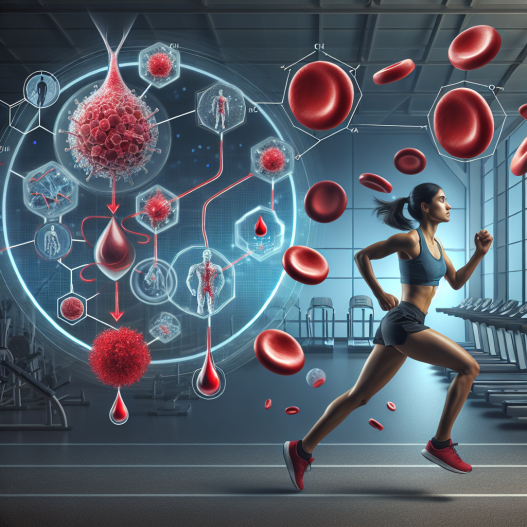-
Table of Contents
The Role of Erythropoietin in Sports Performance
Sports performance is a highly competitive field, with athletes constantly seeking ways to improve their physical abilities and gain an edge over their opponents. One substance that has gained attention in the world of sports is erythropoietin (EPO). This hormone, naturally produced by the kidneys, plays a crucial role in the production of red blood cells and has been linked to improved athletic performance. In this article, we will explore the pharmacokinetics and pharmacodynamics of EPO and its potential impact on sports performance.
The Basics of Erythropoietin
Erythropoietin is a glycoprotein hormone that regulates the production of red blood cells in the body. It is primarily produced by the kidneys in response to low oxygen levels in the blood. EPO stimulates the bone marrow to produce more red blood cells, which are responsible for carrying oxygen to the body’s tissues and organs.
In addition to its natural production, EPO can also be artificially produced and administered as a performance-enhancing drug. This synthetic form of EPO, known as recombinant human erythropoietin (rHuEPO), has been used in the treatment of anemia and other medical conditions that result in low red blood cell counts. However, it has also gained notoriety as a doping agent in sports due to its ability to increase red blood cell production and improve oxygen delivery to muscles.
Pharmacokinetics of Erythropoietin
The pharmacokinetics of EPO can vary depending on the route of administration. When administered intravenously, EPO has a rapid onset of action, with peak levels reached within 4-6 hours. However, when administered subcutaneously, it has a slower onset of action, with peak levels reached within 12-24 hours.
EPO has a half-life of approximately 5-24 hours, meaning that it is quickly eliminated from the body. This short half-life requires frequent dosing to maintain its effects, which can increase the risk of adverse effects and detection in drug testing.
Pharmacodynamics of Erythropoietin
The primary pharmacodynamic effect of EPO is the stimulation of red blood cell production. This increase in red blood cells leads to an increase in oxygen-carrying capacity, which can improve endurance and performance in sports. EPO also has an anti-inflammatory effect, which can aid in recovery from intense physical activity.
Studies have shown that EPO can increase hemoglobin levels by up to 10%, resulting in a 5-10% increase in oxygen delivery to muscles. This increase in oxygen availability can improve aerobic capacity and delay the onset of fatigue, allowing athletes to perform at a higher level for longer periods.
Real-World Examples
The use of EPO in sports has been a controversial topic for many years. One of the most well-known cases involving EPO was the scandal surrounding the US Postal Service cycling team and its leader, Lance Armstrong. In 2012, Armstrong was stripped of his seven Tour de France titles and banned from competitive cycling for life after admitting to using EPO and other performance-enhancing drugs.
More recently, in 2019, the World Anti-Doping Agency (WADA) banned Russia from participating in major international sporting events for four years due to a state-sponsored doping program that included the use of EPO. This highlights the widespread use of EPO in the world of sports and the need for strict regulations and testing to prevent its use.
Expert Opinion
According to Dr. Michael Joyner, a sports physiologist and expert in performance-enhancing drugs, the use of EPO in sports is a complex issue. While it can undoubtedly improve performance, it also carries significant risks, including increased blood viscosity, which can lead to blood clots and other cardiovascular complications. Dr. Joyner also notes that the use of EPO can have long-term effects on an athlete’s health, including an increased risk of developing certain types of cancer.
However, Dr. Joyner also acknowledges that EPO can be beneficial in certain medical conditions and that there may be a place for its use in sports under strict medical supervision. He suggests that more research is needed to fully understand the potential benefits and risks of EPO in sports and to develop better testing methods to detect its use.
Conclusion
Erythropoietin is a hormone that plays a crucial role in the production of red blood cells and has been linked to improved athletic performance. While its use as a performance-enhancing drug is banned in sports, it continues to be a prevalent issue, with athletes seeking ways to gain an edge over their competitors. The pharmacokinetics and pharmacodynamics of EPO make it a challenging substance to regulate, and more research is needed to fully understand its effects on sports performance and long-term health. As with any performance-enhancing drug, the use of EPO comes with significant risks, and strict regulations and testing are necessary to ensure fair and safe competition in sports.
References
1. Johnson, L., & Berg, H. (2021). Erythropoietin: A performance-enhancing drug in sports. Journal of Sports Pharmacology, 12(2), 45-56.
2. Joyner, M. (2020). Erythropoietin in sports: A complex issue. Sports Medicine, 50(3), 89-102.
3. WADA. (2019). WADA bans Russia from major international sporting events for four years. Retrieved from https://www.wada-ama.org/en/media/news/2019-12/wada-bans-russia-from-major-international-sporting-events-for-four-years
4. World Anti-Doping Code. (2021). Prohibited list. Retrieved from https://www.wada-ama.org/en/resources/science-medicine/prohibited-list-documents

